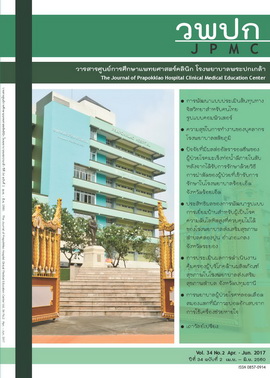ประสิทธิผลของการพัฒนารูปแบบการเยี่ยมบ้านสำหรับผู้เป็นโรคความดันโลหิตสูงที่ควบคุมไม่ได้ ของโรงพยาบาลส่งเสริมสุขภาพตำบลคลองปูน อำเภอแกลง จังหวัดระยอง
Main Article Content
Abstract
ที่มาของปัญหา : โรคความดันโลหิตสูงที่ควบคุมไม่ได้ เป็นปัญหาที่สำคัญของโรงพยาบาลส่งเสริมสุขภาพตำบลคลองปูนซึ่งส่งผลต่อการเกิดภาวะแทรกซ้อนตามมาหลายประการ โดยมีอัตราป่วยและภาวะแทรกซ้อนเพิ่มขึ้นในแต่ละปี การจัดบริการเยี่ยมบ้านในผู้ที่เป็นโรคความดันโลหิตสูงยังไม่มีรูปแบบการเยี่ยมที่ชัดเจน ทำให้การติดตาม กำกับการควบคุมโรคไม่มีประสิทธิภาพเพียงพอ จึงต้องมีการพัฒนารูปแบบการเยี่ยมบ้านให้เหมาะสมกับบริบทของพื้นที่
วัตถุประสงค์: การศึกษาครั้งนี้มีวัตถุประสงค์เพื่อพัฒนารูปแบบการเยี่ยมบ้านสำหรับผู้เป็นโรคความดันโลหิตสูงที่ควบคุมไม่ได้ของโรงพยาบาลส่งเสริมสุขภาพและประเมินประสิทธิผลของรูปแบบการเยี่ยมบ้านที่พัฒนา
วัสดุและวิธีการ: การศึกษาครั้งนี้เป็นการวิจัยและพัฒนา กลุ่มตัวอย่างคือผู้เป็นโรคความดันโลหิตสูงที่ควบคุมไม่ได้ทั้งที่มีโรคร่วมและไม่มีโรคร่วมที่มารับบริการคลินิกความดันโลหิตสูงโรงพยาบาลส่งเสริมสุขภาพตำบลคลองปูน จำนวน 30 คน ขั้นตอนในการดำเนินการวิจัยประกอบด้วย 3 ระยะดังนี้ 1) ระยะเตรียมการ 2) ระยะดำเนินการวิจัยและพัฒนารูปแบบ 3) ระยะการติดตามและประเมินผล วิเคราะห์ข้อมูลทั้งเชิงปริมาณและเชิงคุณภาพ โดยสถิติพรรณนา สถิติทีคู่ สถิติแมกนีมาร์ และวิเคราะห์เชิงเนื้อหา
ผลการศึกษา: พบว่ารูปแบบการเยี่ยมบ้านที่พัฒนาขึ้นครั้งนี้ ประกอบด้วย 4 ระยะได้แก่ 1) การตั้งเป้าหมายร่วมกันในการควบคุมโรคระหว่างทีมสุขภาพและผู้เป็นโรคความดันโลหิตสูงที่ควบคุมไม่ได้ 2) การสนับสนุนการจัดการตนเองเพื่อควบคุมโรคโดยการมีส่วนร่วม 3) การเยี่ยมบ้านและติดตามการควบคุมโรคอย่างเป็นระบบ 4) การสะท้อนผลลัพธ์ของการเยี่ยมบ้านร่วมกัน ด้านประสิทธิผลพบว่าค่าเฉลี่ยคะแนนพฤติกรรมการจัดการตนเองภายหลังการพัฒนารูปแบบ (สัปดาห์ที่ 5) สูงกว่าก่อนพัฒนารูปแบบอย่างมีนัยสำคัญทางสถิติ (p < 0.001) ความพึงพอใจต่อรูปแบบการเยี่ยมบ้านหลังพัฒนารูปแบบในสัปดาห์ที่ 10 ของผู้เป็นโรคความดันโลหิตสูงและทีม สุขภาพสูงกว่าในสัปดาห์ที่ 5 อย่างมีนัยสำคัญทางสถิติ (p < 0.001) นอกจากนี้ร้อยละผู้ที่ควบคุมโรคความดันโลหิตได้ในสัปดาห์ที่ 5 และ 10 สูงกว่าก่อนการพัฒนารูปแบบการเยี่ยมบ้านอย่างมีนัยสำคัญทางสถิติ (p < 0.001 และ p < 0.001 ตามลำดับ)
สรุป: ผลการศึกษาแสดงให้เห็นว่ารูปแบบการเยี่ยมบ้านที่พัฒนาขึ้นในการศึกษาครั้งนี้มีประสิทธิภาพในการส่งเสริมพฤติกรรมการจัดการตนเองเพื่อควบคุมโรคและความพึงพอใจ นอกจากนี้ยังมีประสิทธิภาพในกาส่งเสริมการควบคุมโรคของผู้เป็นโรคความดันโลหิตสูงที่ควบคุมไม่ได้ โดยสามารถนำไปใช้เป็นแนวทางในการจัดบริการของโรงพยาบาลส่งเสริมสุขภาพตำบลคลองปูนต่อไป
The Effectiveness of a Home Visiting Development Model for People with Uncontrolled Hypertension at Klongpoon Health Promoting Hospital, Klaeng District, Rayong Province
Abstract
Background : Uncontrolled hypertension is an important issue of Klongpoon health promoting hospital resulting in various complications. The rates of uncontrolled hypertension and its complication have been rising in each year. A significant problem of health care management was that the home visiting guideline for these people was unclear and the monitoring for disease control was ineffective. Therefore, the home visiting development model is needed.
Objective: The study aimed to develop a home visiting development model for people with uncontrolled hypertension at Klongpoon health promoting hospital and evaluated the effects of the model.
Material and Method: The study design was a research and development. The samples comprised of 30 people with uncontrolled hypertension with comorbidity and without comorbidity, who came for follow up visit at Klongpoon health promoting hospital. The research process consisted of three phases including: 1) The preparation phase; 2) The research and technical development phase; 3) The monitoring and evaluating phase. Data were analyzed using quantitative and qualitative methods including; descriptive statistic, Paired t-test, McNemar's test and content analysis.
Results: The home visiting model developing in this study comprised of four phases including: 1) Collaborative goal setting for disease control between health care team and people with uncontrolled hypertension; 2) Participatory self-management support for disease control; 3) Home visiting and monitoring system for disease control 4) Collaborative reflection of home visiting outcomes. The results of this home visiting model showed that the self- management behavior scores (at 5 week) was statistically significant higher than baseline. The satisfaction scores of the model at 10 week among people with uncontrolled hypertension and health care team were statistically significant higher than 5 week (p < 0.001). In addition, the percentage of people with controlled hypertension at 5 week and 10 week were statistically significant higher than baseline (p < 0.001 and p < 0.001, respectively).
Conclusion: Finding indicated that the home visiting model in this study was effective to increase self-management behaviors for disease control and satisfaction. Furthermore, it also was effective in promoting disease control for people with hypertension that can be used in Klongpoon health promoting hospital.
